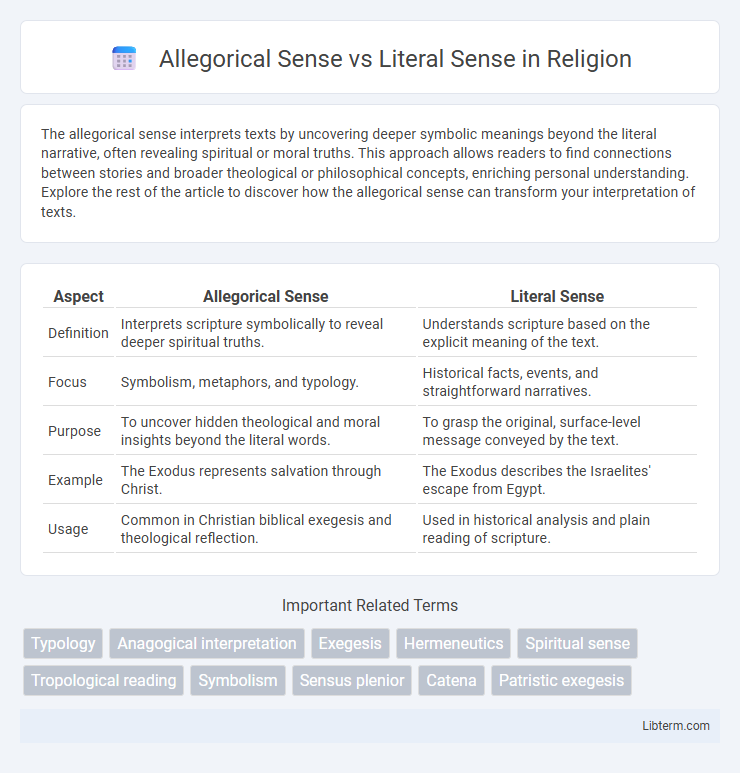The allegorical sense interprets texts by uncovering deeper symbolic meanings beyond the literal narrative, often revealing spiritual or moral truths. This approach allows readers to find connections between stories and broader theological or philosophical concepts, enriching personal understanding. Explore the rest of the article to discover how the allegorical sense can transform your interpretation of texts.
Table of Comparison
| Aspect | Allegorical Sense | Literal Sense |
|---|---|---|
| Definition | Interprets scripture symbolically to reveal deeper spiritual truths. | Understands scripture based on the explicit meaning of the text. |
| Focus | Symbolism, metaphors, and typology. | Historical facts, events, and straightforward narratives. |
| Purpose | To uncover hidden theological and moral insights beyond the literal words. | To grasp the original, surface-level message conveyed by the text. |
| Example | The Exodus represents salvation through Christ. | The Exodus describes the Israelites' escape from Egypt. |
| Usage | Common in Christian biblical exegesis and theological reflection. | Used in historical analysis and plain reading of scripture. |
Introduction to Allegorical and Literal Senses
The literal sense refers to the direct, explicit meaning of a text, focusing on the actual events, characters, and facts described. The allegorical sense involves interpreting the text symbolically, uncovering deeper spiritual or moral meanings beyond the surface narrative. Understanding both senses is crucial for comprehensive biblical exegesis and theological study.
Defining Literal Sense: Meaning and Importance
The literal sense in biblical interpretation refers to understanding the text according to its explicit meaning and the ordinary use of language at the time it was written. It provides the foundational framework for grasping the text's original message, historical context, and authorial intent. Emphasizing the literal sense ensures accurate comprehension before exploring deeper allegorical or symbolic meanings.
Understanding Allegorical Sense: An Overview
The allegorical sense interprets biblical texts by uncovering deeper spiritual meanings beyond the literal words, revealing connections to Christ, the Church, or divine truths. This method contrasts with the literal sense, which emphasizes the direct, surface-level meaning based on historical and grammatical context. Understanding the allegorical sense enriches scriptural study by highlighting symbolic significance and theological insights embedded within the text.
Historical Development of Biblical Interpretation
The historical development of biblical interpretation reveals a dynamic tension between the allegorical sense and the literal sense, with early Church Fathers like Origen advocating for allegorical readings to uncover deeper spiritual meanings beyond the literal text. During the medieval period, scholars such as Thomas Aquinas systematized the fourfold sense of Scripture, integrating literal, allegorical, moral, and anagogical interpretations as complementary layers. The Protestant Reformation emphasized a return to the literal sense, promoting direct engagement with the biblical text to correct perceived medieval excesses and prioritize historical context.
Key Differences Between Allegorical and Literal Approaches
The allegorical sense interprets texts by uncovering hidden, symbolic meanings that convey spiritual or moral lessons, whereas the literal sense focuses on the explicit, surface meaning of words as intended by the original author. Key differences include the allegorical approach's emphasis on metaphor, symbolism, and deeper theological significance, contrasting with the literal approach's reliance on historical context, factual accuracy, and straightforward interpretation. Understanding these distinctions is essential in biblical exegesis and literary analysis to appreciate both surface narratives and layered meanings.
Examples of Literal Sense in Texts
The literal sense refers to the straightforward, primary meaning of a text, conveying facts and events exactly as described without symbolism or metaphor. For example, in the Bible, the story of Noah building the ark and surviving the flood is taken literally as a historical event in its literal sense. Another illustration is the parable of the Good Samaritan, where the literal sense details a man helping another who was beaten and left by the roadside.
Examples of Allegorical Sense in Scripture
The allegorical sense of Scripture interprets biblical narratives as symbols pointing to deeper spiritual truths, such as viewing the Passover lamb in Exodus as a prefiguration of Christ's sacrifice in the New Testament. Another example is the crossing of the Red Sea, which allegorically represents Christian baptism and liberation from sin. Paul's interpretation of Sarah and Hagar in Galatians 4 highlights the allegorical layer where Sarah represents the covenant of promise and Hagar symbolizes the old covenant of the law.
Theological Implications of Both Senses
Theological implications of the allegorical sense reveal deeper spiritual truths and Christological meanings, enriching biblical interpretation by connecting Old Testament events to New Testament fulfillment. The literal sense emphasizes the historical and grammatical context, establishing the factual foundation necessary for accurate theological analysis. Balancing both senses ensures a comprehensive understanding of Scripture, fostering robust doctrine and authentic faith practice.
Common Misconceptions and Debates
Common misconceptions about Allegorical Sense versus Literal Sense often arise from the assumption that the allegorical approach undermines historical accuracy, when in fact it seeks deeper moral or spiritual meanings beyond the plain narrative. Debates frequently center on whether a text's primary interpretation should prioritize factual content or symbolic significance, with scholars arguing that both senses can coexist to enrich understanding. Misinterpretations also occur when allegorical readings are applied too liberally, obscuring the original context and leading to subjective or anachronistic conclusions.
The Value of Integrating Both Perspectives
Integrating allegorical and literal senses enriches biblical interpretation by combining concrete historical context with deeper spiritual meanings. This dual approach allows readers to grasp the text's surface narrative while uncovering symbolic layers that convey theological truths. Balancing these perspectives enhances comprehension, fostering a more holistic understanding of sacred scriptures.
Allegorical Sense Infographic

 libterm.com
libterm.com